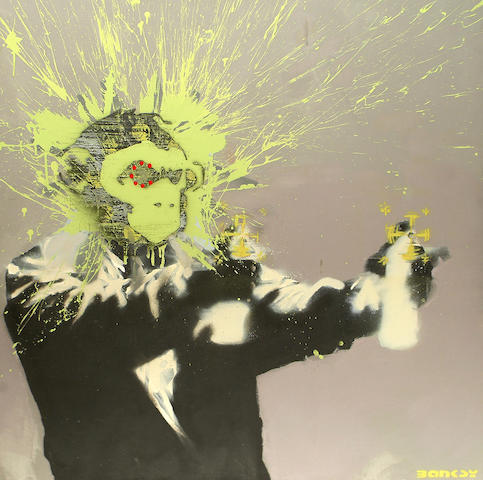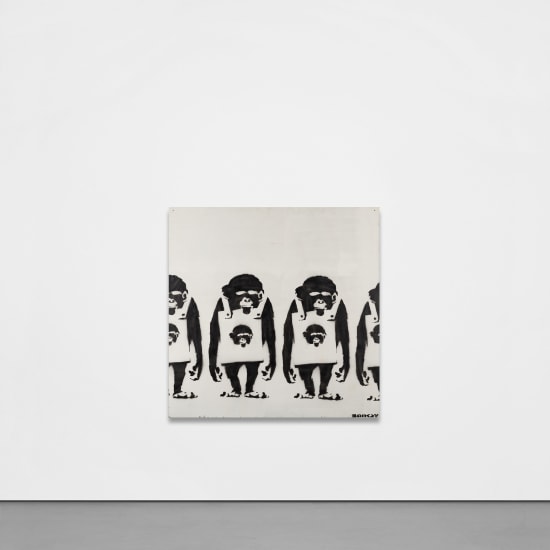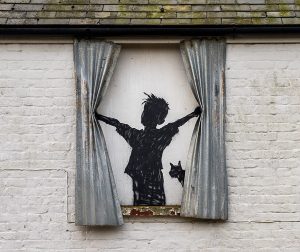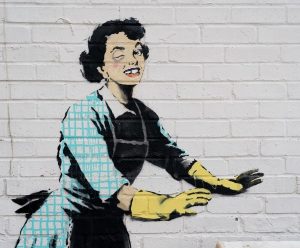
Laugh Now Monkeys with Monkey Placards, 2000
Spray-paint on board
122×122 cm (48×48 inches)
Stenciled with the artist’s name ‘BANKSY’ (lower right)
Phillips London: 3 March 2022
Estimated GBP 1,500,000 – 2.500,000
Presented for the first time at auction, Laugh Now Monkeys with Monkey Placard has an exceptional provenance and a fascinating history, representing an important moment in Banksy’s transition from underground street artist to anti-establishment icon. Commissioned directly by the present owner for his hip-hop club in 2000, the work predates the larger Laugh Now mural that appeared in Brighton’s Ocean Rooms nightclub in 2002. Often cited as the first commission of the iconic money stencil, this later Laugh Now work cemented the reputation of Banksy – and of street art more broadly – within its art historical contexts, even setting a record for Banksy’s work when it was presented at auction in 2008. Much like this later work, Laugh Now Monkeys with Monkey Placard came out of a very culturally specific time and place, in the international intersection of music, street art, and style that was happening in the late 1990s and early 2000s.

Installation shot of Graffiti Art in Bristol, organized by the Arnolfini in Bristol in 1985
The influence of music and a Bristol-bred subculture of graffiti that included artists like 3D, Nick Walker, and Inkie on the anonymous Banksy’s early development are well-documented, and on being invited to this new city for the commission of the present work Banksy immediately engaged with the environment and the burgeoning graffiti culture he found there. As well as the works commissioned for this venue, Banksy left a host of spontaneous guerrilla stencils dotted throughout the city, a record of his time there, and the foundation for a thriving street art scene that continues today.

Rivington Street, London, 2002
Executed in black spray paint using Banksy’s signature monochrome stencil technique, Laugh Now Monkeys with Monkey Placard ranks amongst the most important early examples of the guerrilla street artist’s most enduring and instantly recognizable motifs. Closely cropped, the work shows four upright chimpanzees, shoulders sloping under the weight of the identical placards placed over the heads. A recurring and particularly provocative character in Banksy’s repertoire, the monkey embodies his darkly comic approach to satire and social commentary, touching on issues related to inequality, political resistance, and protest that underpins the street artist’s entire project.

Alongside his trademark rat, Banksy’s monkeys are amongst his most recognizable characters, and like the rat – that derided, shunned, and heavily-policed pest – Banksy has adopted the animal as something of a totem figure for the guerrilla graffiti artist himself. In his Self-Portrait from the same year Banksy presents himself wielding two spray cans and monkey head. Developing out of an early need for anonymity that has only become more pronounced as the years have passed, the monkey head disguise also features prominently in the 2010 film Exit Through the Gift Shop.
Given its evolutionary proximity to humans, the monkey also makes a witty point about the perception of graffiti and street art as ‘uncivilized’ and ‘untrained’ in the context of cultural elitism, classism, and perceptions around ‘high art’. In this way Banksy’s monkey motif ‘apes’ the satirical tradition of Singerie in which monkeys, often dressed as humans, are depicted dressed in the fashions of the time and engaged in human behavior as a visual means of satirizing the vanity and foolishness of its target. Typical to Banksy’s approach, the monkey allows him to ‘reframe global issues through the use of irony, and ironic inversion’, a means of highlighting ‘the kinds of power structures and hypocrisy that global ethical agendas must contend with.’i

Alexandre-Gabriel Decamps, Monkey Painter, 1840
Wallraf-Richartz-Museum, Cologne. Image: akg-images
As with related and later Laugh Now pieces, the present work makes use of the iconic stencil and frontal presentation of a lineup of downcast chimpanzees, placard strapped over their shoulders. The title of the present work anticipates the later Ocean Rooms piece, and the slogan ‘laugh now but one day we’ll be in charge’ that appears most frequently on the placards of its various reinterpretations. Although the slogan itself does not appear on the placards of the present work, the references to it here, along with the cropping of the image to imply an infinite multiplication of their numbers, creates an evocative image of the oppression of the many by the few. A satire of power and the powerless, in a typically double-sided manner, it also highlights our capacity for resistance. Replacing the ominous warning with a picture of their own heads, Laugh Now Monkeys with Monkey Placard seems to suggest that if the oppressed could organize, revolution could, in fact, be possible.
“I use monkeys in my pictures for a lot of reasons […] guerrilla tactics, cheeky monkeys, the fact that we share 98.5 per cent of our DNA with them. If I want to say something about people, I use a monkey.”

Before this 2000 commission, the stenciled figure had been appearing in unexpected public spaces for some time. Significantly, the motif appeared in Banksy’s first – and now legendary – exhibition in London in 2000, the same year that the present work was executed. Indeed, it was a visit to London’s East End during these glory years that prompted the commission in the first place. As Banksy recounts of the exhibition: ‘A week later we came back to the same tunnel with two buckets of paint and a letter. The letter was a forged invoice from a mickey mouse Arts organization wishing us luck with the “Tunnel Vision mural project”. We hung up some decorator’s signs nicked off a building site and painted the walls white wearing overalls. We got the artwork up in twenty-five minutes and held an opening party later that week with beers and some hip hop pumping out the back of a transit van”.

Staging what the flyer invitation described as ‘an illicit outdoor gallery experience’ Banksy populated Rivington Street in London’s Shoreditch area with twelve stencils, including an iteration of the present work featuring the monkey stencils. Although no murals of the work now survive, it remains an enduring image of British counterculture and the thriving street art scene in the years leading up to the millennium.



